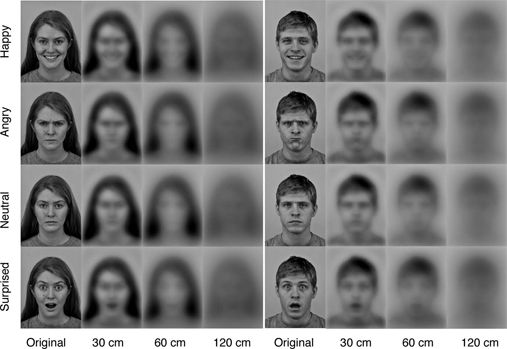
By combining technology, mathematics and previous knowledge of the visual perception of infants, researchers have finally succeeded in showing to an adult audience how much of its environment a newborn baby can actually see. The results tell us that an infant of 2 to 3 days old can percieve faces, and perhaps also emotional facial expressions, at a distance of 30 centimeters – which corresponds to the distance between a mother and her nursing baby. If the distance is increased to 60 centimeters, the visual image gets too blurred for the baby to perceive faces and expressions.
The study was conducted by researchers at the Institute of psychology in collaboration with colleagues at the University of Uppsala and Eclipse Optics in Stockholm, Sweden.
Live pictures
The study plugs a gap in our knowledge about infants' visual world, which was left open for several decades. It may also help explain claims that newborn babies can imitate facial expressions in adults during the first days and weeks of their lives, long before their vision is sufficiently developed to perceive details in their environments. The key word is motion.
«Previously, when researchers have tried to estimate exactly what a newborn baby sees, they have invariably used still photos. But the real world is dynamic. Our idea was to use images in motion,» says professor emeritus Svein Magnussen from the Institute of Psychology.
Testing an old idea

Early in his career, Magnussen conducted research into the visual perception of humans. One day, about 15 years ago, he found himself discussing with colleagues the problem of testing whether newborn infants are really able to perceive facial expressions in people around them. The researchers agreed that if it were true that babies could see and imitate facial expressions, the reason might be that the faces were moving.
«Back then we had neither the equipment nor the technical competence to test our idea. We dug it out again only a year ago. So, our results are based on an old idea which nobody had tested in the meantime,» he says.
What makes facial expressions intelligible?
In order to carry out the test, the researchers had to combine modern simulation techniques with previous insight into how infants' vision works. We have a great deal of information about young infants' contrast sensitivity and spatial resolution from behavioural studies conducted, for the most part, in the 80s. At that time, it was discovered that presenting an infant with a figure against a uniformly grey background, caused the infant to direct its gaze towards the figure.
«Figures made up of black and white stripes were used. By choosing a certain stripe width and frequency, the field would appear uniformly grey, and the child would not direct its gaze towards it. Changing the width and frequency to make up figures, made it possible to determine the exact level of contrast and spatial resolution needed to make the infant direct its gaze towards the figure,» Magnussen says.
In othe words, the researchers had access to quite accurate information about newborn infants' vision. What was unknown to them, was the practical consequences of this information. Does it, for instance, mean that a newborn baby can see the expression in the face of an adult bending over the baby?
Movement is easier to see
It's easier to recognise something that moves, than a blurry still photo. The researchers made video recordings of faces that changed between several emotional expressions, and subsequently filtered out the information which we know is unavailable to newborn infants. Then they let adult participants see the videos. The idea was that if the adults were unable to identify a facial expression, then we can certainly assume that a newborn would also be unable to do so.
The adult participants correctly identified facial expressions in three out of four cases when viewing the video at a distance of 30 centimeters. When the distance was increased to 120 centimeters, the participants' rate of identification were about what one could expect from random responding. This means that the ability to identify facial expressions based on the visual information available to a newborn baby, reaches its limit at a distance of about 30 centimeters.
The complete set of simulated images used in the experiment, containing the facial expressions of feeling surprised, happy, angry and neutral. Video by Olof von Hofsten/Eclipse Optics and Bruno Laeng/UiO.
Filling a gap in the foundation wall
«It's important to remember that we have only investigated what the newborn infant can actually see, not whether they are able to make sense of it,» Magnussen points out.
Previous attempts to recreate the newborn baby's visual reality, for instance in students' textbooks, have usually relied on taking a normal photograph and blur it. Magnussen confesses himself surprised that nobody before them have made use of the detailed information we possess about infants' visual perception. Hence this is the first time that we have a concrete estimate of the visual information available to the newborn baby.
Magnussen and his colleagues are happy to finally have been able to carry out an idea that had been on the back burner for fifteen years. But as for developing their results further, they will leave that to others.
«All of us behind this study are really involved in different fields of research now. Our position is: Now a piece of the foundation is in place. If anyone else wants to follow up, that's up to them,» says Magnussen.
Reference:
Svein Magnussen et al. "Simulating newborn face perception", Journal of Vision, doi: 10.1167/14.13.16, Summary.